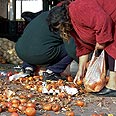
Being poor in Israel more than just a matter of wages, it's also about ethnicity and social status, the National Insurance Institute (NII) reported Sunday.
In its annual poverty report, the NII revealed that the levels of poverty in the ultra-Orthodox community are about four times higher than in the secular community. The most indigent sector of the population, according to the NII, is the Bedouins, where the level of poverty is eight times higher than in the secular Jewish population: Some 80% of Bedouins who live in un-registered settlement are reportedly living below the poverty line.
The National Insurance Institute 2007 report revealed that last year, more than 1.6 million Israelis lived under the poverty line – and that 805,000 of them were children. The NII allotted benefits to the amount of NIS 47 billion (approx. $13 billion) – a two billion shekel increase from 2006.
The report further detailed poverty segmentation according to social affiliation, noting that 14% of secular Jews were poor; as are 19 of the immigrants who arrived at Israel after 1990; 32% of Israeli Christians and 35% of the single-parent household.
Forty percent of all Druze live under the poverty line, as do 50% of the Arab-Muslim households. Next on the list is the ultra-Orthodox community, where 57% of households are defined as poor. Bedouins living in registered communities are listed next, with 61% living under the poverty line.
Dr. Daniel Gottlieb, of the NII's research department, said that considerable differences in poverty levels between communities are rooted in is lack of basic infrastructure such as education, water, power and roads; adding that the continuance neglects of indigent populations will only worsen their situation.
The report also noted that despite being employed, many families have fallen under the Poverty line. A surprising statistic indicates that the number of working families who are considered poor has risen by 65% between 1990 and 2007.















